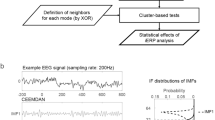Abstract
The recorded electrical activity of complex brain networks through the EEG reflects their intrinsic spatial, temporal and spectral properties. In this work we study the application of new penalized regression methods to i) the spatial characterization of the brain networks associated with the identification of faces and ii) the PARAFAC analysis of resting-state EEG. The use of appropriate constraints through non-convex penalties allowed three types of inverse solutions (Loreta, Lasso Fusion and ENet L) to spatially localize networks in agreement with previous studies with fMRI. Furthermore, we propose a new penalty based in the Information Entropy for the constrained PARAFAC analysis of resting EEG that allowed the identification in time, frequency and space of those brain networks with minimum spectral entropy. This study is an initial attempt to explicitly include complexity descriptors as a constraint in multilinear EEG analysis.




Similar content being viewed by others
References
Pascual-Marqui, R.D.: Review of methods for solving the EEG inverse problem. Int. J. Bioelectromagn. 1, (1), 75–86 (1999)
Durka, P.J., Blinowska, K.J.: A unified time–frequency parametrization of EEG. IEEE Eng. Med. Biol. 20, (5), 47–53 (2001)
Makeig, S., Westerfield, M., Jung, T.P., Enghoff, S., Townsend, J., Courchesne, E., Sejnowski, T.J.: Dynamic brain sources of visual evoked responses. Science 295, 690–694 (2002)
Miwakeichi, F., Martínez-Montes, E., Valdés-Sosa, P.A., Nishiyama, N., Mizuhara, H., Yamaguchi, Y.: Decomposing EEG data into space–time–frequency components using Parallel Factor Analysis. Neuroimage 22, (3), 1035–1045 (2004)
Harrison, L., Penny, W.D., Friston, K.: Multivariate autoregressive modeling of fmri time series. Neuroimage 19, 1477–1491 (2003)
Freiwald, W.A., Valdés, P.A., Bosch, J., Biscay, R., Jiménez, J.C., Rodríguez, L.M., Kreiter, A.K., Singer, W.: Testing non-linearity and directness of interactions between neural groups in the macaque inferotemporal cortex. J. Neurosci. Methods 94, 105–119 (1999)
Friston, K.J., Holmes, A.P., Worsley, K.J., Poline, J.P., Frith, C.D., Frackowiak, R.S.J.: Statistical parametric maps in functional imaging: a general linear approach. Hum. Brain Mapp. 2, (4), 189–210 (1994)
Kiebel, S.J., Tallon-Baudry, C., Friston, K.J.: Parametric analysis of oscillatory activity as measured with EEG/MEG. Hum. Brain Mapp. 26, 170–177 (2005)
Fan, J.Q., Li, R.Z.: Variable selection via nonconcave penalized likelihood and its oracle properties. J. Am. Stat. Assoc. 96, 1348–1360 (2001)
Tibshirani, R.: Regression shrinkage and variable selection via the lasso. J. R. Stat. Soc. Ser. B 58, 267–288 (1996)
Zou, H., Hastie, T.: Regularization and variable selection via the elastic net. J. R. Stat. Soc. Ser. B 67, 301–320 (2005)
Hunter, D.R., Li, R.: Variable selection using MM algorithms. Ann. Stat. 33, 1617–1642 (2005)
Valdés-Sosa, P.A., Sánchez-Bornot, J.M., Vega-Hernández, M., Melie-García, L., Lage-Castellanos, A., Canales-Rodríguez, E.: Granger causality on spatial manifolds: applications to neuroimaging. In: Schelter, B., Winterhalter, M., Timmer, J. (eds.) Handbook of Time Series Analysis: Recent Theoretical Developments and Applications, pp. 461–492. Wiley-VCH, Weinheim (2006)
Land, S., Friedman, J.: Variable fusion: a new method of adaptive signal regression. Technical Report. Department of Statistics, Stanford University, Stanford (1996)
Shannon, C.E.: A mathematical theory of communication. Bell Syst. Tech. J. 27, 379–423, 623–656 (1948)
Vega-Hernández, M., Sánchez-Bornot, J.M., Lage-Castellanos, A., Martínez-Montes, E., Valdés-Sosa, P.A.: Penalized regression methods for solving the EEG inverse problem. NeuroImage 27(1) (2006) (CD-ROM)
Golub, G.H., Heat, M., Wahba, G.: Generalized cross-validation as a method for choosing a good ridge parameter. Technometrics 21, 215–223 (1979)
Bro, R.: Multi-way analysis in the food industry: Models, algorithms and applications. PhD thesis, University of Amsterdam and Royal Veterinary and Agricultural University, Denmark, (1998)
Martínez-Montes, E., Sánchez-Bornot, J.M., Valdés-Sosa, P.A.: Generalized penalized PARAFAC analysis of EEG time series. NeuroImage, 36(S1), (2007) (CD-ROM)
Mardia, K., Kent, J., Bibby, J.: Multivariate analysis. Academic Press, San Diego, CA (1979)
Kanwisher, N., McDermott, J., Chon, M.M.: The fusiform area: a module in human extrastriate cortex specialized for face perception. J. Neurosci. 17, 4302–4311 (1997)
Martínez-Montes, E., Valdés-Sosa, P.A., Miwakeichi, F., Goldman, R.I., Cohen, M.S.: Concurrent EEG/fMRI analysis by multi-way partial least squares. NeuroImage 22, (3), 1023–1034 (2004)
Acknowledgments
The authors thank Mark Cohen and Jhoanna Pérez-Hidalgo-Gato for kindly providing the data of the resting EEG and face identification experiment used in this study.
Author information
Authors and Affiliations
Corresponding author
Rights and permissions
About this article
Cite this article
Martínez-Montes, E., Vega-Hernández, M., Sánchez-Bornot, J.M. et al. Identifying Complex Brain Networks Using Penalized Regression Methods. J Biol Phys 34, 315–323 (2008). https://doi.org/10.1007/s10867-008-9077-0
Received:
Accepted:
Published:
Issue Date:
DOI: https://doi.org/10.1007/s10867-008-9077-0




